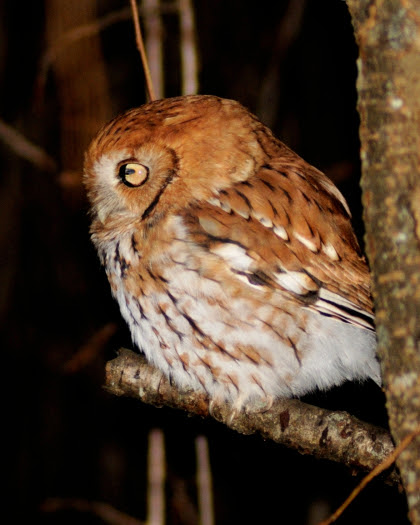By the Light of the Silvery Spring Moon
Article and photos by Joe Mish

The last full moon of winter rose in the night sky to escape the clouds which hung just above the horizon. As the moon passed above this dark velvet curtain, an infinite army of dark shadows suddenly appeared and stood tall in contrast to the silver-gray tinted background. Though the moon light turned night into day, all color melted into shades of gray.
A chorus of spring peepers provided backup music to solo performances by pickerel frogs, toads and green frogs. The sound ebbed and flowed with brief moments of sudden silence as if to gather audience attention. The amphibian love fest seemed heightened by the silvery mood light hovering high above. The calls professing infinite amphibian love, also attract predators whose love extends only to a dietary delight. The flash of a low flying owl, was revealed as moonlight reflected off its white under feathers during a sharp turn. This aerial pirouette coincided with a dead silence from the chorus of frogs. When the sounds of love returned, haltingly at first, then to full volume, it was impossible to tell if there was now one less second tenor.
Turning back from the meadow, I began to scan the moonlit surface of the gently flowing river. Any disturbance in the perfectly smooth, glass-like water surface would reveal the presence of some otherwise elusive creature or unfolding drama. Locally common aquatic furbearers, mink, beaver, muskrat, along with land dwellers, especially raccoon, are most active at night and may occasionally be seen.
There was a substantial inventory of sticks and barely exposed rocks causing irregularities in the smooth water that had to be checked off as false positives. It became a game of concentration to recall which disturbance to ignore. One sure sign of interest is the half circle pattern of ripples moving out from the shore, perpendicular to the water flow. Many a muskrat leaving its submerged bank den will send telltale ripples to preface its appearance. Same goes for mink, or raccoon investigating nooks and crannies in the labyrinth of tree roots. One night, a large wake appeared to reveal the presence of a barge size raccoon, paddling from shore to island. The moonlight revealed a perfectly dry ball of fur, slowly swimming, as if to not get its hair wet. It soon disappeared into the deep shadows of the island’s trees.
Another moonlit night, during very low water, the smooth water flow was interrupted by something walking from shore to island a distance away and partially obscured by branches. I fully expected to see a deer as its relatively long legs dismissed the possibility of a raccoon. I was shocked to see a fox walking in the water. The digital image captured is visual blur but clearly shows a red fox willing to get its feet wet for something its nose demanded to investigate.
Though the natural world is a never ending, non-stop feature film, we see only out of context isolated frames which are inadequate to understand the complexity and co-dependence of the natural community of which we are an inseparable part.
The light of a full moon becomes the movie projector used to provide an opportunity to see what goes on in the dark of night and add needed perspective to our knowledge of the natural world.
Note some moon fun facts. The diameter of the moon is less than the width of the United States. A case of “objects in the mirror appear closer than they really are.” The moon’s axial rotation matches exactly the time it takes to orbit the earth. The moon is capable of raising and lowering the sea level, triggering migrations and influencing animal and human behavior. Bird migrations are associated with the full moon and in the case of woodcock, provide a well-lit stage for a display of early spring mating flights. A recent study has found that a protein exists in birds’ eyes which allow it to actually see and navigate by the blue light generated from the magnetic poles. The influence of moon phase on migration and animal activity is well documented. See Solunar Tables by John Alden Knight, Also Richard Alden Knight https://www.usprimetimes.com/theory.html for more information on sun, moon and tide affects on behavior.
Author Joe Mish has been running wild in New Jersey since childhood when he found ways to escape his mother’s watchful eyes. He continues to trek the swamps, rivers and thickets seeking to share, with the residents and visitors, all of the state’s natural beauty hidden within full view. To read more of his writing and view more of his gorgeous photographs visit Winter Bear Rising, his wordpress blog. Joe’s series “Nature on the Raritan, Hidden in Plain View” runs monthly as part of the LRWP “Voices of the Watershed” series. Writing and photos used with permission from the author. Contact jjmish57@msn.com. See more articles and photos at winterbearrising.wordpress.com.
